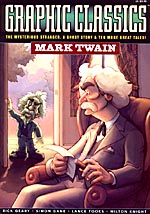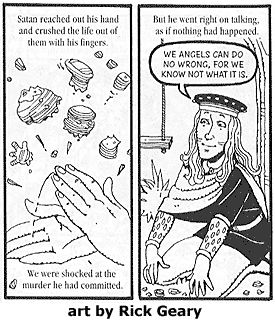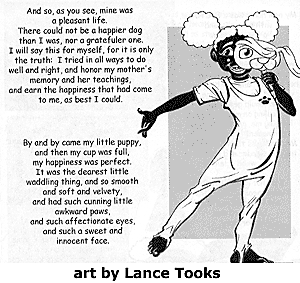 Edited by Tom Pomplun
Edited by Tom Pomplun
144 pages, black and white
Published by Eureka Productions
Growing up, two of my favorite books to read over and over again were Mark Twain’s The Adventures of Tom Sawyer and Huckleberry Finn. It wasn’t until I got older that I really started to discover that Twain was also a writer of numerous short stories, linked together by a display of wit and cunning. I remember wishing at the time that someone had marketed his short stories to younger readers. I may be older now, but I’m no less delighted to see that Graphic Classics: Mark Twain seems to be doing just that.
 Graphic Classics: Mark Twain takes a handful of Twain’s stories and lets different comic creators adapt them into this new medium. Easily the most successful entry here is Rick Geary’s version of “The Mysterious Stranger”, where an angel named Satan appears in a small town, promising to help a group of children. Geary perfectly catches the mistrust, suspicion, and twists that are the hallmarks of “The Mysterious Stranger”. The rhythm of Twain’s original story is kept perfectly, with each new incident both being a relief and then a concern to the reader. Geary’s art goes a long way towards maintaining this, with Satan’s innocent face beaming off the page, helping lower your defenses with its open and simplistic art style.
Graphic Classics: Mark Twain takes a handful of Twain’s stories and lets different comic creators adapt them into this new medium. Easily the most successful entry here is Rick Geary’s version of “The Mysterious Stranger”, where an angel named Satan appears in a small town, promising to help a group of children. Geary perfectly catches the mistrust, suspicion, and twists that are the hallmarks of “The Mysterious Stranger”. The rhythm of Twain’s original story is kept perfectly, with each new incident both being a relief and then a concern to the reader. Geary’s art goes a long way towards maintaining this, with Satan’s innocent face beaming off the page, helping lower your defenses with its open and simplistic art style.
That’s not to say, of course, that you can’t put a little more detail into the art of a Twain story. Kevin Atkinson’s version of “The Celebrated Jumping Frog of Calaveras County” has nice, full-figured art that brings to the foreground the larger-than-life aspect of the story. Jim Smiley looks just like I’d always imagined him, and there’s a certain warmth to the comic adaptation that brought a big smile to my face.
 What’s nice about Graphic Classics: Mark Twain is that it’s not afraid to adapt things in a slightly different manner than just the normal panels and word balloons. Lance Tooks’s adaptation of “A Dog’s Tale”, for instance, is illustrated as if we’re watching a theatre performance, complete with actors and puppets. It’s a very clever format, both effectively telling the story and making the finished version as much Tooks’s creation as it is Twain’s.
What’s nice about Graphic Classics: Mark Twain is that it’s not afraid to adapt things in a slightly different manner than just the normal panels and word balloons. Lance Tooks’s adaptation of “A Dog’s Tale”, for instance, is illustrated as if we’re watching a theatre performance, complete with actors and puppets. It’s a very clever format, both effectively telling the story and making the finished version as much Tooks’s creation as it is Twain’s.
With the wide variety of art styles on display, I was pleased that I enjoyed almost all of them, from the realistic drawings of Dan E. Burr to the incredibly stylized creations of Simon Gane (who adapted one of my favorite Twain stories, “Is He Living Or Is He Dead?”). The only one that didn’t work for me was Anton Emdin’s version of “Ghost Story”, where the cartoonish faces are so overwhelmingly large in each panel (and usually crammed into the space with a word balloon or two to boot) that I actually found myself getting a little claustrophobic as I read the story.
By the time I finished reading Graphic Classics: Mark Twain, I’d already resolved to buy a copy for the library where an acquaintance teaches elementary school. This is a fantastic sampling of Twain’s short stories, with a little something for everyone. Even better was discovering that this is the eighth volume in the
Purchase Links:
